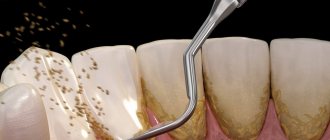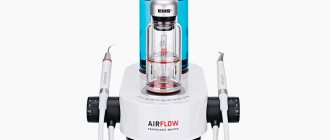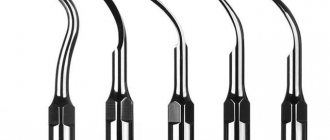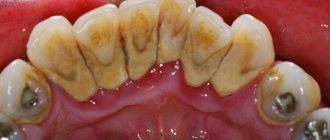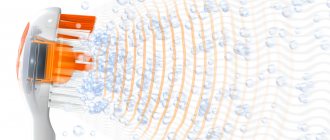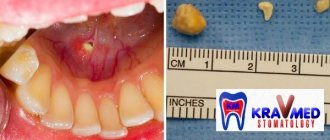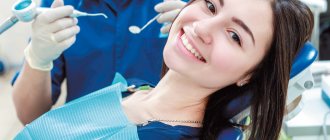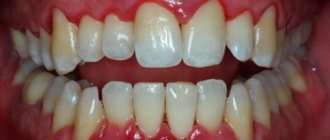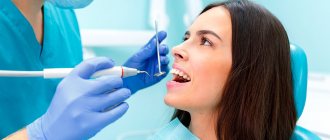Types of Tartar
Tartar has its own classification - according to the field of education. Based on this feature, mineralized deposits are divided into two types:
- Subgingival calculus. Deposits accumulate under the edge of the gums, in the area of the gum pockets. A characteristic feature of subgingival tartar is its increased hardness. Mineralized subgingival deposits can cause an active inflammatory process in the periodontium (soft tissues of the oral cavity) and lead to gingivitis or periodontitis. It is impossible to remove subgingival stone at home: only a dentist can remove deposits in this area;
- Supragingival tartar forms above the gum level and is therefore clearly visible on the teeth. It can become stained from contact with food, and in smokers it has a distinct yellow or brown color. Supragingival tartar harms the healthy state of enamel, increases the risk of caries and, of course, spoils the appearance of teeth. It needs to be removed urgently, because the longer the stone is on the teeth, the denser and harder it becomes.
Symptoms such as the appearance of bad breath, discoloration of the gums, heavy plaque on the teeth after eating, and roughness of the teeth may tell you that tartar has formed on your teeth. If you observe such signs in yourself, be sure to contact the dentist for tartar removal and professional oral hygiene!
How long does plaque take to form and what is its danger?
The primary hardening of dental plaque occurs on average in 6-12 hours, depending on the composition of saliva. If you do not brush or rinse your mouth during this time, then such plaque can no longer be removed simply with a toothbrush. And the more layers of such plaque accumulate on the teeth, the faster a harder layer of tartar forms, since it is easier for microbes to “cling” to the rough surface of the hardened plaque.
In order for the plaque to turn into a sufficiently thick layer of stone , noticeable not only to its owner, but also to others, it takes about 6 months . At the same time, the stone will not stop growing, affecting the gums adjacent to the base of the teeth. The stone will penetrate underneath, filling and enlarging the periodontal pockets and destroying the periodontal ligaments that hold the tooth in the socket. As a result, patients, in addition to aesthetic problems and bad breath, are faced with the problem of inflammation, bleeding and gum recession. The outcome of root caries formation is not uncommon. If we talk about the most negative consequences, then it is precisely the uncleaned tartar in time that causes various stages of gingivitis, periodontitis and even marginal periodontitis (when the infection affects the periodontal ligaments, goes down and causes a cyst or granuloma at the root of the tooth).
Methods for removing tartar used in dentistry
Previously, only mechanical cleaning was used to remove tartar in dentistry, which involved the use of special hand tools: scalers, curettes, excavators, smoothers, chisels, rasps. The procedure was labor-intensive, long and painful for the patient, and also very traumatic.
When manually removing tartar, a fairly large layer of healthy tissue was removed from the teeth and this led to unpleasant sensitivity of the teeth and thinning of the tooth enamel. Nowadays, mechanical removal of tartar is used extremely rarely, only in cases where the patient has contraindications to other methods of cleaning teeth from deposits.
Another outdated and rarely used method of removing plaque is to clean teeth from plaque using special chemical solutions.
The teeth were treated with preparations based on alkalis or acids that dissolve mineralized deposits. However, the chemical method of removing tartar is aggressive, it carries a high risk of burns to the soft tissue of the oral cavity, it negatively affects the condition of tooth enamel, so dentists have long abandoned its use. Nowadays, two modern and highly effective methods are used to remove tartar - ultrasonic cleaning and laser cleaning. We will tell you about these technologies in detail below.
Why is fluoridation needed?
Cleaning the dentition from tartar may be accompanied by exposure of the dentinal tubules, and this, in turn, leads to increased tooth sensitivity. To prevent increased sensitivity, fluoridation is carried out - treating the enamel with a gel with an enamel-sealing substance based on copper hydroxide (applied using a tampon).
Techniques used:
- Simple fluoridation - placing a mold with a special solution on the jaw
- Deep fluoridation - applying F-containing varnish separately to each tooth
To achieve a lasting result, it is recommended to repeat the procedure three times at intervals of 1-2 weeks.
To prevent caries, it is recommended to take a course of 10-14 procedures.
Ultrasound removal of tartar
Ultrasonic tartar removal is a technology that allows you to quickly and painlessly remove mineralized plaque without damaging tooth enamel. The procedure will use a special ultrasonic device with a tip - a scaler. The generator in the device creates ultrasonic waves, which are transmitted to the scaler. The frequency of the waves can be adjusted, which gives the dentist the opportunity to choose the most effective and safe mode of operation.
When removing tartar with ultrasound, different types of tips can be used. By changing the tips, the dentist will clean the outer part of the teeth from mineralized deposits and remove plaque in the subgingival area. Effective and rapid removal of tartar is due to a double action:
- An ultrasonic wave is applied to the tip with a certain frequency, creating vibrations that destroy tartar mechanically;
- Since ultrasonic cleaning can be carried out using liquid, the simultaneous supply of water and ultrasonic waves leads to the effect of cavitation or, in simple words, the formation of a large number of microbubbles that loosen tartar and improve the process of its separation from tooth enamel.
The scalers of modern ultrasonic devices are equipped with illumination, which improves the quality of tartar removal.
Ultrasound cleaning and pregnancy: what's the problem?
Although dental care is especially important during pregnancy, ultrasonic cleaning in the early stages of gestation is strongly not recommended due to the fact that ultrasonic waves, imperceptible to us, can disturb the fetus, causing it discomfort.
In addition, in conditions of unstable hormonal levels characteristic of pregnancy, the procedure can cause swelling and bleeding of the gums
Specialists may refuse ultrasound cleaning to a pregnant woman even at later stages if she has:
- Pacemaker
- Dentures
- A number of diseases (ARVI, diabetes mellitus, epilepsy, bronchitis, asthma, sexually transmitted diseases or cancer)
To avoid unforeseen complications, pregnant women should postpone non-urgent procedures until hormonal levels stabilize; As a rule, the risks of dental manipulation are minimized after the second trimester of pregnancy.
Benefits of ultrasonic tartar removal
Ultrasonic tartar removal technology has the following advantages:
- It is highly effective; using ultrasound, it is possible to remove tartar from both the external surfaces of the teeth and the subgingival space;
- When removing tartar, ultrasound does not injure or damage tooth enamel;
- Ultrasound destroys pathogenic microflora in the oral cavity, and therefore removal of stone and plaque by ultrasonic cleaning is an excellent prevention of various dental diseases;
- The procedure for removing tartar using ultrasound is quick and painless for the patient.
The advantages of ultrasonic tartar removal include the affordable price of the service. Ultrasonic cleaning is universal and can be carried out as an independent hygienic procedure or in combination with Air Flow cleaning. It is imperative to remove tartar with ultrasound before dental treatment, prosthetics, implantation, or wearing braces.
Are there any risks?
Removing stone is a procedure that should become mandatory in the life of any person who cares about the health of their teeth. But if mandatory visits to the dental office are gradually becoming a habit for people, not much is known about stone removal.
Using a scaler is a safe procedure if the dentist knows how to use this device. The nozzle of the device constantly oscillates from top to bottom: to avoid damage to the enamel, it must be kept parallel to the tooth surface being treated.
If you have fillings, crowns or veneers, there are certain risks. A poorly placed filling can easily fall out under the influence of ultrasound; the same applies to low-quality cement used to fix crowns. You need to understand that it is poorly placed fillings that can fall out: if the filling of teeth was carried out in compliance with all standards, then ultrasound will not cause any harm.
The procedure for removing stones using ultrasound seems simple, but this is only an appearance. There may also be deposits under the gums, which require some effort to detect. Not every dentist will want to spend his time on this, since subgingival stones are not particularly visible to patients. However, it is these formations that pose the greatest danger, since they lead to the breakdown of tissue near the teeth, their loosening and subsequent loss. Subgingival deposits are largely to blame for the occurrence and development of inflammation in periodontal tissues.
Laser tartar removal
Laser tartar removal has been used in dentistry relatively recently. This technology involves removing mineralized deposits with a directed laser beam. The procedure is quick, painless and has the following advantages:
- High security. The laser beam destroys only plaque and does not damage the enamel and soft tissues of the oral cavity;
- Laser radiation destroys pathogens and stops inflammatory processes;
- Laser tartar removal takes place without discomfort or pain.
The disadvantages of laser tartar removal include a fairly large list of contraindications and the high cost of the procedure.
Ultrasound cleaning procedure
The process is not accompanied by pain and does not cause serious discomfort to the client. Includes several stages:
- Treatment of the dentition with a special solution (jet)
- Application of a special gel to soften hard deposits
- Ultrasonic cleaning
- Fluoridation
- Polishing
The total time for the entire procedure is up to 1.5 hours.
Air Flow for removing tartar
Air Flow is a technology used for professional teeth cleaning. It copes well with pigmented soft plaque, helps lighten tooth enamel to its natural shade, refreshes and disinfects the oral cavity. But with so many advantages, Air Flow is ineffective in the fight against tartar.
If a large amount of hard dental deposits have accumulated in the patient’s oral cavity, to remove them, properly clean with ultrasound or laser and only then use Air Flow.
When should you not brush your teeth with ultrasound?
Despite the atraumatic and highly safe method, ultrasonic cleaning has its contraindications. You will have to choose another method in the following cases:
- with increased tooth sensitivity;
- in the presence of complex orthopedic structures, including braces;
- in the presence of implants;
- patients with tuberculosis and autoimmune diseases;
- during the period of change of bite in children.
It is not recommended to carry out this procedure in the first trimester of pregnancy, with respiratory diseases, or in a state of acute cold.
Is it possible to remove tartar at home?
On the Internet you can find countless recipes that claim to help remove tartar. Most of these recipes involve the use of caustic substances that must be applied to the surface of the teeth and, under the influence of these substances, the tartar should dissolve.
But we do not advise you to conduct such experiments on your health. Using caustic solutions will not help you remove tartar, but it will weaken and destroy tooth enamel and can lead to burns of the soft tissues of the mouth and other unpleasant consequences. In addition, no folk remedies will relieve you of subgingival tartar.
You need to remember that tartar removal should be carried out in a dental clinic, by a competent hygienist who uses safe materials and modern tools in his work! There is no need to be afraid of this procedure - it is painless, and in addition, before removing tartar, you can always apply local anesthesia, which completely removes all possible unpleasant sensations.
The most frequently asked questions from patients about the procedure
How painful is it?
(click to expand) Ultrasound teeth cleaning is a painless procedure, but it may be accompanied by minor discomfort in the presence of subgingival dental deposits - to remove them you need to slightly disturb the gums. Patients with increased sensitivity of the enamel may also complain of pain. In such cases, the doctor will perform cleaning with maximum comfort for the patient, using local anesthesia.
Is ultrasonic cleaning whitening? (click to expand) No, whitening is a completely different procedure, it is carried out using special whitening compounds that are applied to the tooth. A slight lightening of the enamel is due to the fact that after ultrasonic cleaning, the surface of the teeth is polished; sometimes the difference in color is clearly visible.
Is it true that plaque appears on teeth faster after ultrasonic cleaning? (click to expand) No, that's not true. On the contrary, after ultrasonic cleaning followed by polishing the enamel, plaque appears more slowly. Maintaining oral hygiene helps prevent its occurrence: responsible brushing of teeth at least 2 times a day, rinsing the mouth after meals, choosing the right toothpaste. Smoking, excessive consumption of tea and coffee, and metabolic disorders in the body contribute to the rapid appearance of plaque.
Can cleaning damage the enamel? (click to expand) If the procedure is carried out correctly, damage to tooth enamel is excluded. After cleaning, weak and thin enamel is additionally strengthened with remineralizing gels, the enamel is actively saturated with microelements, and it becomes stronger.
What should I do if I have an acute inflammatory process on my gums? (click to expand) Acute inflammation of the gums, accompanied by bleeding, in most cases is a contraindication to ultrasonic teeth cleaning until acute symptoms are relieved. We offer our patients tartar removal simultaneously with gum treatment using the Vector device. This is a specially designed ultrasonic scaler that is equipped with a unique Paro tip that creates special ultrasonic vibrations. The device allows for deeper treatment of periodontal pockets if the patient is diagnosed with periodontitis; Simultaneously with the removal of dental plaque, the enamel is polished with a special polishing liquid. After its use, supragingival and subgingival deposits, inflammation of soft tissues and bleeding are completely eliminated, bad breath disappears, and oral health is restored.
Is the procedure allowed during pregnancy? (click to expand) Ultrasonic teeth cleaning is not only allowed for pregnant women, but is also recommended for mandatory use. This is explained by the frequent occurrence of problems with teeth and gums in pregnant women due to hormonal changes and the need to sanitize the oral cavity before childbirth. The procedure is completely safe for the health of the expectant mother and her baby, but you still need to consult a gynecologist before performing it.
How often should you resort to ultrasonic teeth cleaning? (click to expand) We recommend that our patients have their teeth cleaned with ultrasound every 6-12 months; sometimes, if there is an increased tendency to form plaque, cleaning is done more often. The best solution is to carry out a comprehensive oral hygiene cleaning, which helps maintain oral health and fresh breath.
Ultrasonic teeth cleaning helps prevent the development of many dental diseases, so do not neglect this procedure.
Prevention of tartar formation
Is it possible to prevent tartar from forming? This question is often asked to dentists by patients after dental plaque removal procedures. Alas, there are no technologies in dentistry that would help get rid of tartar once and for all, but prevention can be carried out to promote the formation of deposits in smaller quantities and slow down the rate of their formation.
Effective prevention of tartar formation will include the following measures:
1. Regular brushing of teeth with the correct movements and the right toothbrush and toothpaste. If you don’t know which brush and paste are right for you, the dental hygienists of our clinic in Moscow, “Aesthetica”, will help you find the answer to this question!
2. When brushing your teeth, be sure to use dental floss or special brushes to help remove plaque and food debris from the spaces between your teeth.
3. Buy irrigators that help remove plaque from the subgingival space.
4. Stop smoking, drinking alcohol frequently, reduce the amount of sweet foods in your diet, and eat solid foods.
To remove tartar in a timely manner, visit the dentist once every six months and carry out professional oral hygiene procedures.
Cost of dental plaque removal
We have already written above that this procedure has a cost that is quite affordable for a wide range of patients. But in different clinics the price may be different: this is explained by the fact that different dentists include a different set of procedures in the dental plaque removal service. Most often, a complex is offered that includes ultrasonic teeth cleaning, Air Flow polishing and fluoridation. The cost of such a comprehensive service in Moscow will start at 4,500 rubles.
You can undergo the procedure for removing dental plaque in comfortable conditions and using ultra-modern technologies and equipment in our dental clinic in Moscow - VENSTOM. You can find out all the details about the service and about making an appointment with our specialists by writing to the chat on our website or calling us!
Comprehensive teeth cleaning: service from our dentistry in Moscow “Aesthetica”
To ensure high-quality removal of tartar, we offer our patients a comprehensive teeth cleaning service, which includes:
- Ultrasonic cleaning;
- Air Flow cleaning;
- Grinding and polishing of enamel;
- Fluoridation.
An integrated approach to teeth cleaning guarantees a high quality procedure and is an excellent prevention of caries and gum inflammation. After the cleaning procedure, our hygienists will definitely give you recommendations on proper oral hygiene to help keep your teeth beautiful and healthy.
In our clinic, modern equipment is used to carry out comprehensive teeth cleaning, and all conditions have been created for comfortable treatment and procedures. We are proud that we can offer you the best dental technologies, high-quality materials from world-famous manufacturers and, of course, our professionalism, knowledge and experience.
Dental clinic “Aesthetica” - with us your teeth will be healthy and your smile will be dazzling! Come to us: we have opened two branches for you in Moscow - in Barvikha and in Podsosensky Lane!
Read more about the possibilities of ultrasonic cleaning
Let's continue the conversation about ultrasonic teeth cleaning - the most effective modern method of removing dental plaque, almost completely safe and capable of cleaning teeth from:
- plaque, including pigmentation;
- stone at the base of the tooth, above and below the gum.
The procedure is performed using an ultrasonic scaler, through which water is supplied through a vibrating metal nozzle: high-frequency vibration destroys deposits on both sides of the tooth, and the water flow washes out these particles. There simply cannot be any hard-to-reach places for an ultrasound scaler.
The effect is complemented by an antibacterial effect. The procedure is indicated for use with a regularity of once a year.
A competent dentist will definitely prescribe teeth cleaning before treatment; before dental operations, the procedure is absolutely necessary.
This treatment will reliably protect against infection by removing bacteria and germs from the oral cavity. Ultrasound cleaning will also help when choosing the color of fillings and implants.
The importance of the procedure during implantation is determined by the following points:
- deep cleaning of periodontal pockets, including hard-to-reach ones;
- disinfection of dental sinuses and canals;
- teeth whitening on both sides;
- prevention of caries and gingivitis.
Main stages of enamel processing
Before examining in detail how to clean and remove tartar with ultrasound, it is necessary to take into account some features of the procedure. So, for example, if a patient experiences inflammatory processes in the gum tissue, or there are signs of periodontitis, it is necessary for the periodontist to do the cleaning. The specialist must know how to properly remove the stone, including removing it from under the gums. If necessary, the doctor will prescribe anti-inflammatory therapy. The process of processing enamel also involves its subsequent mandatory polishing, and ideally also saturation with fluoride. Let's look at each stage in more detail.
Cleaning enamel with a scaler
A special device is used - an ultrasonic scaler (scaler or scaler). It can be a self-installation or a built-in part of dental equipment. The device is equipped with a special tip with a metal attachment, which, in turn, makes oscillatory movements (25-50 kHz) in the ultrasonic range1. The nozzle also provides a powerful stream of water to flush away any remaining deposits.
Surface polishing
The next and no less important stage after treating the enamel with an ultrasonic scaler. This effect on the surface of the teeth allows you to remove the smallest particles of plaque and stone. Currently, two main polishing methods are used in dentistry:
- with the help of brushes and pastes - with their help, all surfaces of the elements of the dentition are treated, and for the interdental spaces they resort to the help of special thin brushes - strips,
- Air Flow is a hardware technique that involves the use of a device of the same name that supplies a high-pressure stream of air and water with the addition of abrasive particles. It is worth noting that “Air Flow” is widely used as an independent method for gently cleaning enamel from soft plaque, and is also very often carried out after ultrasonic cleaning.
The photo shows teeth brushing with the Air Flow system.
The next important step is fluoride treatment. It is not always carried out, but it is desirable that the procedure is still included in comprehensive ultrasonic cleaning.
Treatment of enamel with a fluorine-containing composition - fluoridation
After treatment with ultrasound and Air Flow, teeth become especially susceptible to the effects of vitamins and minerals, which means that such a final procedure will have maximum effect. In addition, it will help reduce hyperesthesia in the cervical area - this is where the teeth become especially susceptible after removing hardened deposits. Fluoridation involves applying special gels and varnishes with a high concentration of fluorine and calcium to the enamel.
Fluoridation of teeth will strengthen enamel
Estimated cost of the service
The cost of the procedure at different medical centers may vary. How much it will cost to remove deposits with ultrasound depends on various factors, including whether further processing is carried out with an AirFlow device, what model of scaler is used, as well as on the pricing policy of the institution as a whole.
| Name of institution | Cost of the procedure, rub. |
| "Star-Dent" | 4 000 |
| Lanri Clinic | 3 000 |
| "Denta-El" | 4 900 |
| Smile-at-Once | 3 500 |
| "ONMED" | 5 100 |
The table shows approximate prices for the service in question - please check the exact price when contacting us. You need to understand that this is one of the few ways to remove hard deposits, and therefore protect yourself from caries and many other dental problems.
Ultrasonic cleaning has many undeniable advantages, including absolute safety and highest efficiency. Regularly undergoing such a procedure at least twice a year will be the best protection against inflammation and carious processes. In addition, systematic visits to the dentist’s office are required in any case, because for prevention such visits should be made at least twice a year.
Restrictions to the procedure
It is worth noting that the technique under consideration has certain contraindications. Here are the main restrictions on the use of ultrasound:
- pathologies of blood vessels and heart,
- asthma, tuberculosis and other diseases related to the functioning of the lungs and respiratory system,
- infections, including HIV, hepatitis,
- the presence of implants and prosthetic devices in the mouth,
- children's age (up to 16-18 years),
- increased sensitivity of the enamel layer,
- diabetes,
- oncology,
- epilepsy and other disorders of the nervous system,
- reduced immunity, which manifests itself in frequent colds and other diseases.
During pregnancy, ultrasonic cleaning is allowed, but in the first trimester it is better to wait. During this period, the expectant mother’s body is overly sensitive and susceptible to any external influences.
Actions after the procedure - prevention
To minimize the intensity of dental plaque formation, proper care and prevention should be provided. To do this, experts recommend adhering to the following rules:
- use a brush whose degree of hardness corresponds to the condition of your enamel - it is better to consult a specialist on this matter,
- carry out standard cleaning daily - after waking up and before going to bed,
- You need to brush your teeth in a circular motion for at least 5 minutes,
- after eating, do not forget to floss, rinse your mouth to remove food debris after a meal,
- for better care, it is worth purchasing an irrigator - a portable device supplies a powerful stream of water and air under high pressure,
- do not forget about the back side of the rows, as well as the surface of the tongue, where a huge number of bacteria are concentrated,
- include hard vegetables and fruits in your diet - when biting, the enamel is cleansed of microbial plaque,
- eat less sweets, limit your consumption of sugary drinks, coffee and black tea. You also need to stop smoking.
A good product for caring for the structure is an irrigator.
To maintain hygiene, it is recommended to undergo comprehensive cleaning twice a year. According to experts, this is the optimal frequency that will prevent the formation of too much deposits that can provoke the development of caries and other dental problems.
